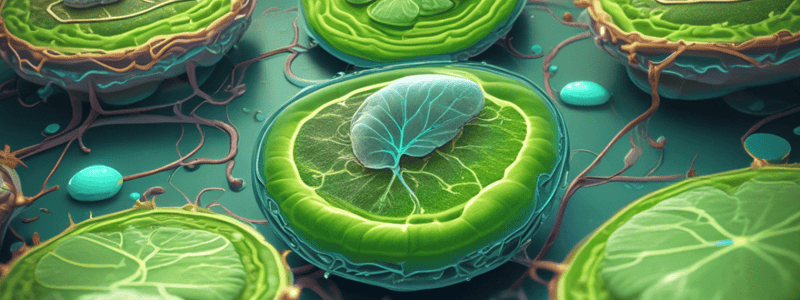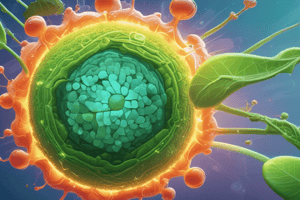Podcast
Questions and Answers
What powers the enzyme complex ATP synthase in photosynthesis?
What powers the enzyme complex ATP synthase in photosynthesis?
- The movement of electrons through the Calvin Cycle
- Protons moving from low concentration in the lumen to high concentration in the stroma
- The flow of H+ from high concentration in the lumen to low concentration in the stroma (correct)
- The splitting of water through photolysis by PSI
What is the primary function of photolysis in photosynthesis?
What is the primary function of photolysis in photosynthesis?
- Convert CO2 to organic carbon chains
- Power the Calvin Cycle
- Generate oxygen and ATP
- Resupply electrons to PSII (correct)
Which molecule is covalently bonded to RuBP by Rubisco in the carbon fixation phase?
Which molecule is covalently bonded to RuBP by Rubisco in the carbon fixation phase?
- CO2 (correct)
- Glyceraldehyde-3-phosphate (G3P)
- ATP
- NADPH
What is the product of the reduction phase in the Calvin Cycle?
What is the product of the reduction phase in the Calvin Cycle?
In photosynthesis, what is the primary role of ATP?
In photosynthesis, what is the primary role of ATP?
Which phase of the Calvin Cycle involves making G3P back into RuBP?
Which phase of the Calvin Cycle involves making G3P back into RuBP?
What is one of the main functions of G3P produced in photosynthesis?
What is one of the main functions of G3P produced in photosynthesis?
What happens when electrons flow from high concentration in the lumen to low concentration in the stroma?
What happens when electrons flow from high concentration in the lumen to low concentration in the stroma?
Which component of photosynthesis involves storing energy in chemical bonds by fixing carbon from CO2?
Which component of photosynthesis involves storing energy in chemical bonds by fixing carbon from CO2?
What is the significance of NADPH in photosynthesis?
What is the significance of NADPH in photosynthesis?
Which of the following is the primary function of photosynthesis?
Which of the following is the primary function of photosynthesis?
In eukaryotic cells, where does the process of photosynthesis take place?
In eukaryotic cells, where does the process of photosynthesis take place?
What is the primary role of Photosystem II in the light reactions?
What is the primary role of Photosystem II in the light reactions?
What is the primary function of the cytochrome complex in the electron transport chain?
What is the primary function of the cytochrome complex in the electron transport chain?
What is the role of plastocyanin (PC) in the light reactions?
What is the role of plastocyanin (PC) in the light reactions?
What is the primary function of Photosystem I in the light reactions?
What is the primary function of Photosystem I in the light reactions?
What is the role of ferredoxin (FD) in the light reactions?
What is the role of ferredoxin (FD) in the light reactions?
What is the primary role of the proton gradient generated across the thylakoid membrane?
What is the primary role of the proton gradient generated across the thylakoid membrane?
What is the final product of the light reactions?
What is the final product of the light reactions?
Flashcards are hidden until you start studying
Study Notes
Light Reactions
- H+ flow from high concentration in the lumen to low concentration in the stroma drives ATP synthase, resulting in ATP formation in the stroma (photophosphorylation)
- Electrons leave the light reactions in NADPH, and new electrons are obtained by splitting water through photolysis by PSII
- These low-energy electrons resupply PSII, while the by-products (H+ and oxygen) are useful but not required for photosynthesis
- The role of photolysis is to generate new electrons by splitting water
Electron Transport Chain
- Photosystem II donates high-energy electrons to an electron transport chain (ETC) starting with the high-energy electron carrier PQ
- PQ reduces cytochrome complex, which uses the energy from the electrons to pump hydrogen ions across the membrane into the thylakoid lumen, generating a H+ gradient
- The low-energy electrons are then used to reduce PC, the last step in the ETC
- Photosystem I accepts the low-energy electrons from PC and re-excites them back to a high-energy level
ATP Synthesis
- ATP is formed during the light reactions using the energy generated from the H+ gradient
- ATP synthase is driven by the H+ flow from the lumen to the stroma
Calvin Cycle
- The Calvin Cycle fixes inorganic carbon from CO2 into organic carbon chains, storing energy in chemical bonds
- CO2 is covalently bonded to the 5C molecule RuBP by the enzyme Rubisco, generating two 3C organic molecules in the carbon fixation phase
- The product of the reduction phase is glyceraldehyde-3-phosphate (G3P)
- One G3P is exported while five go to the regeneration phase and are made back into three molecules of RuBP
Photosynthesis and Cellular Respiration
- Photosynthesis transforms light energy into chemical energy, and is part of the carbon cycle synthesizing new carbon backbones from CO2 released during cellular respiration
Chloroplasts and Components
- In eukaryotes (plants and algae), photosynthesis occurs in the chloroplasts, using components in the stroma, thylakoid membranes, and the thylakoid lumen
- The chloroplast has three compartments: stroma, thylakoid membranes, and thylakoid lumen
Studying That Suits You
Use AI to generate personalized quizzes and flashcards to suit your learning preferences.




